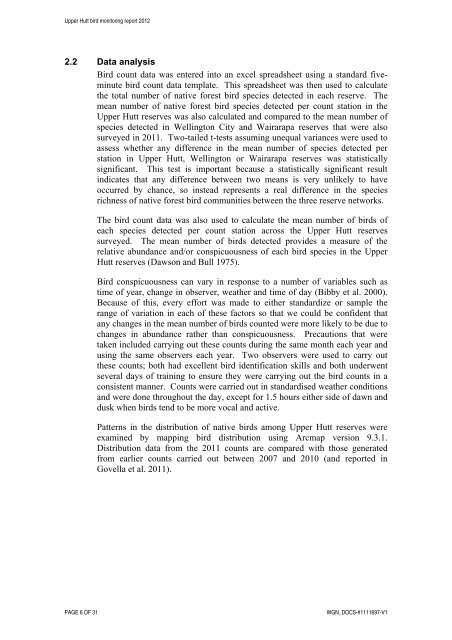State and trends in the diversity, abundance and distribution of birds ...
State and trends in the diversity, abundance and distribution of birds ...
State and trends in the diversity, abundance and distribution of birds ...
Create successful ePaper yourself
Turn your PDF publications into a flip-book with our unique Google optimized e-Paper software.
Upper Hutt bird monitor<strong>in</strong>g report 2012<br />
2.2 Data analysis<br />
Bird count data was entered <strong>in</strong>to an excel spreadsheet us<strong>in</strong>g a st<strong>and</strong>ard fivem<strong>in</strong>ute<br />
bird count data template. This spreadsheet was <strong>the</strong>n used to calculate<br />
<strong>the</strong> total number <strong>of</strong> native forest bird species detected <strong>in</strong> each reserve. The<br />
mean number <strong>of</strong> native forest bird species detected per count station <strong>in</strong> <strong>the</strong><br />
Upper Hutt reserves was also calculated <strong>and</strong> compared to <strong>the</strong> mean number <strong>of</strong><br />
species detected <strong>in</strong> Well<strong>in</strong>gton City <strong>and</strong> Wairarapa reserves that were also<br />
surveyed <strong>in</strong> 2011. Two-tailed t-tests assum<strong>in</strong>g unequal variances were used to<br />
assess whe<strong>the</strong>r any difference <strong>in</strong> <strong>the</strong> mean number <strong>of</strong> species detected per<br />
station <strong>in</strong> Upper Hutt, Well<strong>in</strong>gton or Wairarapa reserves was statistically<br />
significant. This test is important because a statistically significant result<br />
<strong>in</strong>dicates that any difference between two means is very unlikely to have<br />
occurred by chance, so <strong>in</strong>stead represents a real difference <strong>in</strong> <strong>the</strong> species<br />
richness <strong>of</strong> native forest bird communities between <strong>the</strong> three reserve networks.<br />
The bird count data was also used to calculate <strong>the</strong> mean number <strong>of</strong> <strong>birds</strong> <strong>of</strong><br />
each species detected per count station across <strong>the</strong> Upper Hutt reserves<br />
surveyed. The mean number <strong>of</strong> <strong>birds</strong> detected provides a measure <strong>of</strong> <strong>the</strong><br />
relative <strong>abundance</strong> <strong>and</strong>/or conspicuousness <strong>of</strong> each bird species <strong>in</strong> <strong>the</strong> Upper<br />
Hutt reserves (Dawson <strong>and</strong> Bull 1975).<br />
Bird conspicuousness can vary <strong>in</strong> response to a number <strong>of</strong> variables such as<br />
time <strong>of</strong> year, change <strong>in</strong> observer, wea<strong>the</strong>r <strong>and</strong> time <strong>of</strong> day (Bibby et al. 2000).<br />
Because <strong>of</strong> this, every effort was made to ei<strong>the</strong>r st<strong>and</strong>ardize or sample <strong>the</strong><br />
range <strong>of</strong> variation <strong>in</strong> each <strong>of</strong> <strong>the</strong>se factors so that we could be confident that<br />
any changes <strong>in</strong> <strong>the</strong> mean number <strong>of</strong> <strong>birds</strong> counted were more likely to be due to<br />
changes <strong>in</strong> <strong>abundance</strong> ra<strong>the</strong>r than conspicuousness. Precautions that were<br />
taken <strong>in</strong>cluded carry<strong>in</strong>g out <strong>the</strong>se counts dur<strong>in</strong>g <strong>the</strong> same month each year <strong>and</strong><br />
us<strong>in</strong>g <strong>the</strong> same observers each year. Two observers were used to carry out<br />
<strong>the</strong>se counts; both had excellent bird identification skills <strong>and</strong> both underwent<br />
several days <strong>of</strong> tra<strong>in</strong><strong>in</strong>g to ensure <strong>the</strong>y were carry<strong>in</strong>g out <strong>the</strong> bird counts <strong>in</strong> a<br />
consistent manner. Counts were carried out <strong>in</strong> st<strong>and</strong>ardised wea<strong>the</strong>r conditions<br />
<strong>and</strong> were done throughout <strong>the</strong> day, except for 1.5 hours ei<strong>the</strong>r side <strong>of</strong> dawn <strong>and</strong><br />
dusk when <strong>birds</strong> tend to be more vocal <strong>and</strong> active.<br />
Patterns <strong>in</strong> <strong>the</strong> <strong>distribution</strong> <strong>of</strong> native <strong>birds</strong> among Upper Hutt reserves were<br />
exam<strong>in</strong>ed by mapp<strong>in</strong>g bird <strong>distribution</strong> us<strong>in</strong>g Arcmap version 9.3.1.<br />
Distribution data from <strong>the</strong> 2011 counts are compared with those generated<br />
from earlier counts carried out between 2007 <strong>and</strong> 2010 (<strong>and</strong> reported <strong>in</strong><br />
Govella et al. 2011).<br />
PAGE 6 OF 31<br />
WGN_DOCS-#1111697-V1
















